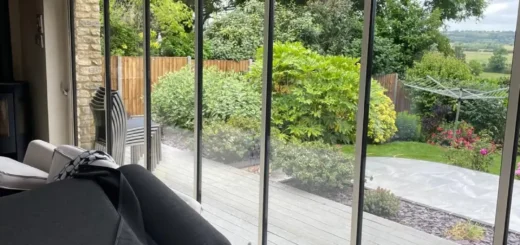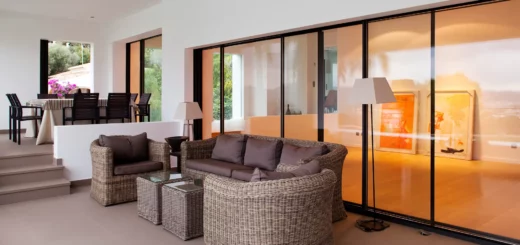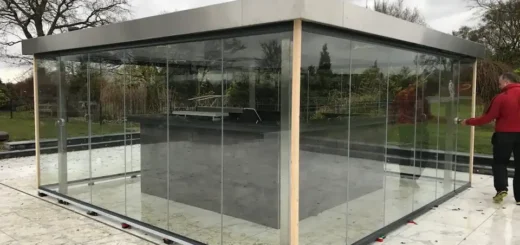Picking Your Perfect Aluminium Folding Doors
Table of Contents
Moving glass walls that fold back against themselves bring extra light and flexibility to British homes. Often called bifold doors, bi-folding doors, or glass concertina doors, aluminium folding doors consist of multiple glass panels that fold and stack neatly to one or both sides of an opening, accordion or concertina style.
What Are Aluminium Folding Doors?
Aluminium folding doors combine strength and slim frames to create wide openings between spaces. Each panel connects to the next using sturdy hinges, letting you fold them back like a paper concertina. The entire system runs smoothly on a track, with panels gliding along top and bottom rails when opened or closed.
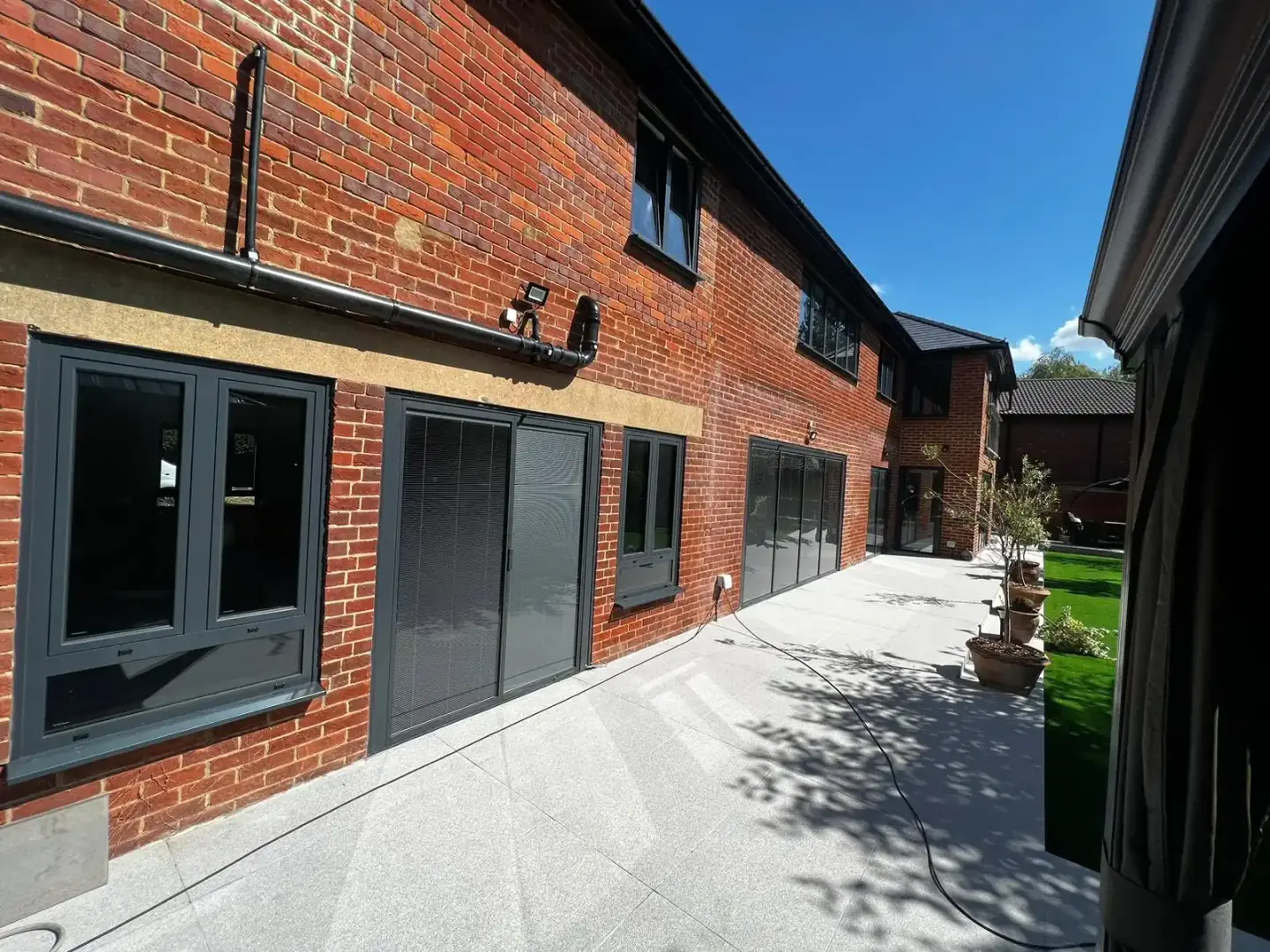
Opening Systems
Multi-point locking systems secure each panel at multiple points along its height. Top-hung aluminium bifold doors carry their weight from above, while bottom-rolling systems rest on the lower track. Most door sets use either two, three, four, or five panels, though larger openings might need more. The panels stack flat against the wall or each other when fully opened.
Main Components
Strong aluminium frames hold large glass panes in place using thermal breaks—strips of insulating material that separate the inner and outer sections. Different panel configurations affect how the aluminium folding doors operate: some fold all panels to one side, while others split to both sides. Weather-resistant seals between panels keep the elements out, making aluminium folding patio doors ideal for outdoor spaces.
Two parallel tracks guide the movement of bifold door systems. The top track bears most of the weight in top-hung designs, requiring solid structural support above. Bottom tracks can be recessed into the floor, creating a flush threshold that’s easy to step over. Regular cleaning of these tracks helps maintain smooth operation.
Aluminium Folding Doors vs Other Materials
Modern folding doors come in four main materials. While uPVC costs less upfront, timber gives a classic look, and steel provides industrial style, aluminium bifold doors strike a unique balance of benefits.
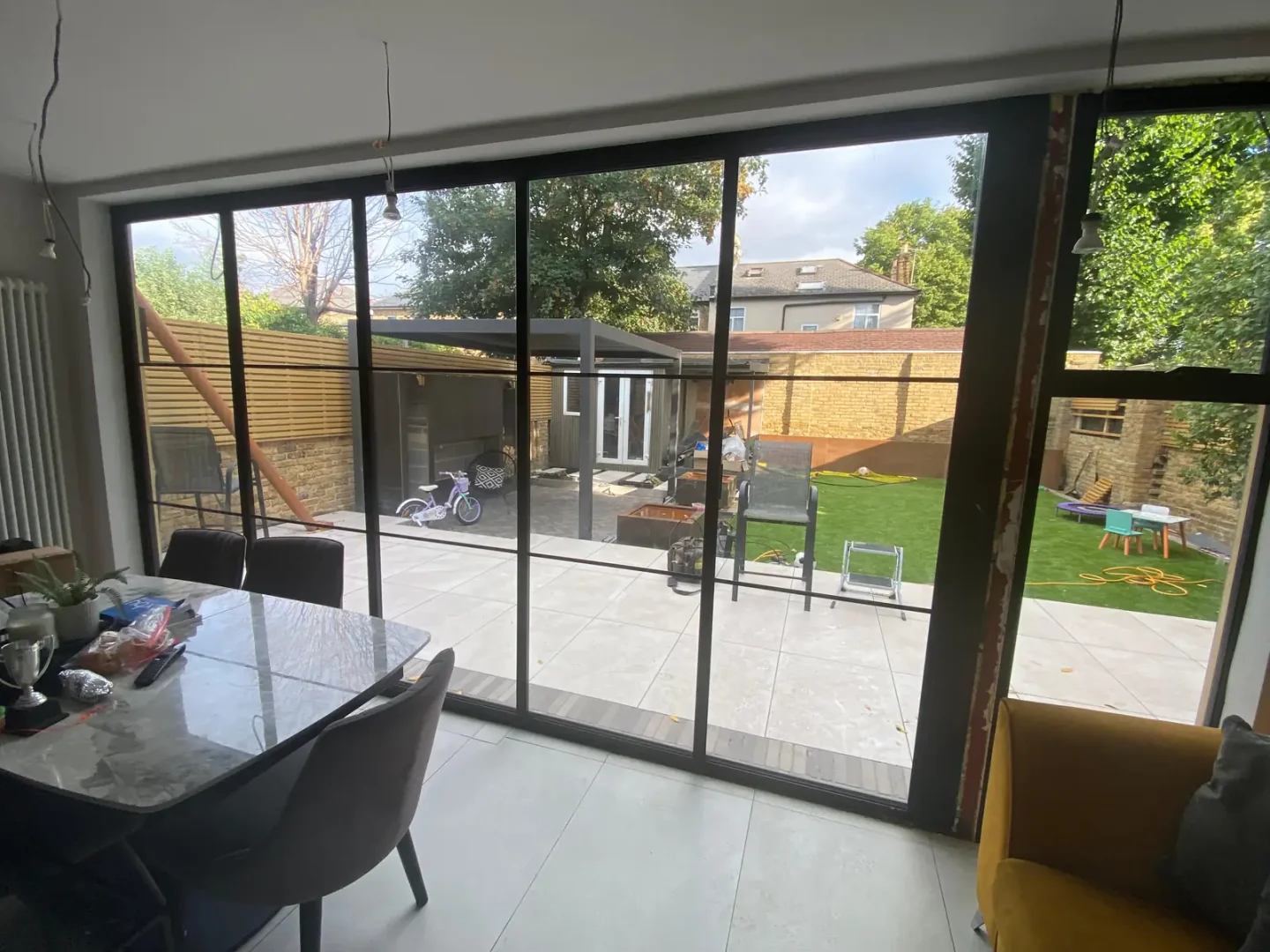
Material Properties
Each material affects what’s possible with your doors. Timber needs regular maintenance to stay looking good, and its frame sections must be thicker to maintain strength. By contrast, aluminium folding doors allow larger glass panels thanks to their inherent strength. Steel offers similar benefits but costs more and conducts heat readily. uPVC frames need extra bulk to achieve the same structural stability, which means less glass and more frame.
- Timber: High maintenance, classic look
- uPVC: Budget-friendly, bulky frames
- Steel: Industrial style, expensive
- Aluminium: Strong, slim frames
Weather Protection
British weather puts doors through their paces. Rain, wind, and temperature swings test every joint and seal. The outer frame of aluminium bi-fold doors won’t warp or twist like timber can. Salt air near the coast speeds up wear on most materials, but powder-coated aluminium stands firm. Modern coating techniques mean these doors need just occasional cleaning with soapy water.
Sustainability
Making aluminium uses lots of energy initially, but bifold patio doors made from this metal can be fully recycled at the end of their life. The energy efficient nature of aluminium folding doors comes from their durability and thermal breaks. These plastic strips inside the frames block heat transfer, helping to cut energy bills. While timber grows back, the treatments needed to protect it often contain chemicals that make recycling difficult.
Frames and Glass in Aluminium Folding Doors
Modern architectural design puts glazing at its heart. Strong yet slim frames strike a perfect visual balance, and nowhere is this more evident than in aluminium folding doors, where engineering meets pure design. The way these frames look affects not just the view but how your space feels.
Frame Sizes
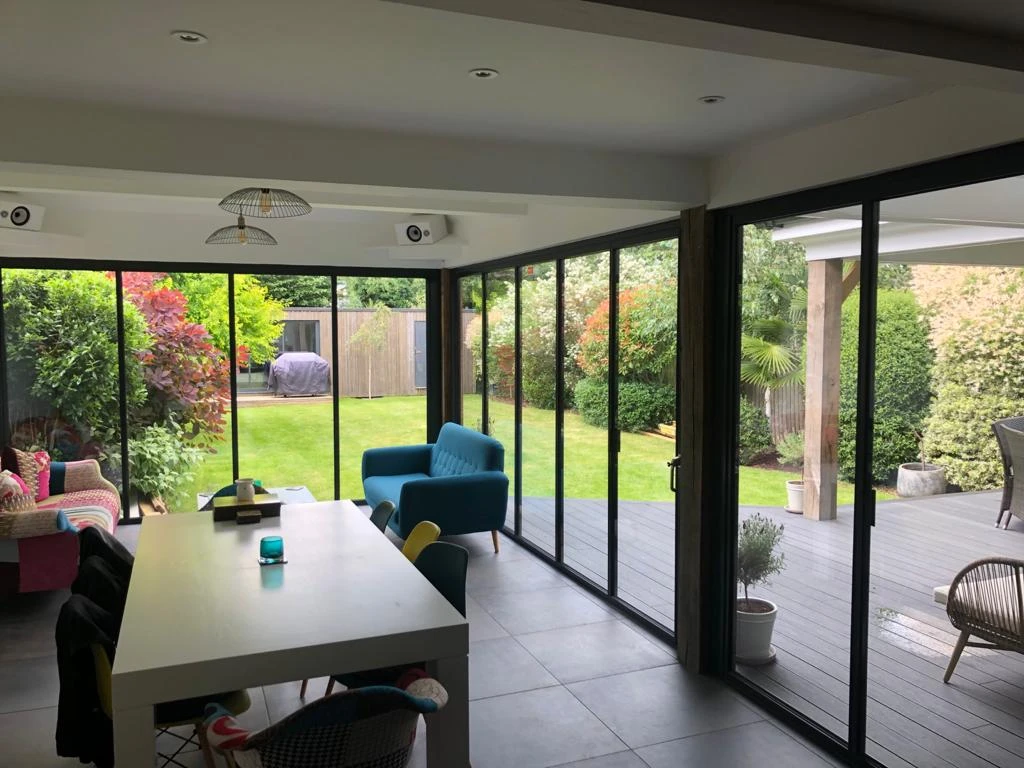
Precise engineering has pushed the boundaries of what’s possible with bi fold aluminium doors. Every millimetre of frame thickness affects both visual impact and practical performance—contrary to what you might expect, thicker isn’t always better. A major home improvement project like this deserves careful attention to these seemingly small details that make a big difference to the end result.
Today’s slim sight lines in modern bifold aluminium doors come from decades of refinement in manufacturing techniques. The strength-to-weight ratio of aluminium means frames can be narrower than other materials while supporting the same glass weight. External aluminium bifold doors need this strength to handle daily use without sagging or sticking.
Modern coating technology protects these slender frames from wear and tear. Advanced powder coating techniques bond the colour deep into the metal’s surface, giving lasting protection that won’t chip or fade like paint might. This tough outer layer keeps the visual appeal fresh for years with minimal upkeep.
Glass Options
Double glazing comes as standard, while triple glazing suits colder spots or noise-prone areas. Modern glass coatings cut glare and help control temperature, making these installations more practical than ever before. Safety glass adds peace of mind, especially in busy family homes where accidents might happen.
Choosing glass means weighing up several factors. Low-iron glass gives the clearest views but costs more than standard glazing. Solar control coatings reduce heat gain in sunny rooms, while acoustic lamination cuts noise transmission. Self-cleaning glass suits high windows where regular cleaning proves tricky. Each choice affects both comfort and running costs in different ways.
Different panel sizes create varying effects in your space. Aluminium is better suited for large folding doors than other materials as it can accommodate larger panel sizes, but the width-to-height ratio changes how they feel—too tall and narrow can look awkward, while very wide panels might become unwieldy. The proportions typically work best when they follow classical ratios that please the eye naturally.
Getting these ratios right determines the overall impact. Aluminium bifold doors need frames that complement both contemporary and traditional homes without drawing attention away from the views beyond. When opened fully, the panels should stack neatly without creating visual clutter or blocking sight lines to the outside.
The final appearance depends on how light plays across the frames throughout the day. Morning sun catches different angles than evening light, making the frames appear thicker or thinner as shadows shift. This interplay of light and shadow adds subtle depth to your space as the day progresses.
External Aluminium Folding Doors
Thermal Performance
From driving rain to frosty mornings, aluminium folding doors prove their worth through superior build quality and lasting performance. When temperatures drop, their advanced thermal breaks keep warmth inside.
British homes lose much of their heat through poorly fitted doors. Aluminium bifolding doors tackle this issue with multi-chambered frames and tight seals. The thermal efficiency of modern designs matches or beats traditional door types, helping to cut heating bills throughout winter.
Opening up your living space to the garden changes how you use your home. Bi fold aluminium doors stack neatly to the side, creating wide openings that bring fresh air and natural light inside. These systems work particularly well in south-facing rooms where good ventilation matters most.
Modern aluminium folding doors use advanced glass units, sometimes filled with argon gas, and equipped with special coatings to reduce heat loss. These technical features trap heat effectively while letting plenty of light through.
Bifolding doors with built in blinds offer extra control over light and privacy. The blinds sit between the glass panes, protected from dust and damage. They never need cleaning and won’t clatter in the breeze.
Security of Aluminium Folding Doors
When it comes to security, external doors need top-notch locking systems. Each panel in aluminium folding doors locks securely at multiple points, making them highly resistant to break-in attempts. Quality hardware and strong frames work together to keep your home safe.
Some spots need extra thought, like homes near the coast or in exposed locations. Salt spray can attack lesser materials, but powder-coated aluminium stands up well to coastal conditions. Powder coated aluminium bi fold doors just need an occasional wipe with soapy water to stay looking fresh.
The thermal performance of modern aluminium bi fold doors is much higher than older systems. Special breaks in the frame stop cold from creeping inside, while warm-edge spacer bars between glass panes add extra insulation. Your home stays cosy even when winter bites.
Too much sun can make rooms uncomfortably hot. Aluminium bifold doors can include solar control glass that cuts glare and heat gain without making spaces feel dark or gloomy.
Internal Aluminium Folding Doors
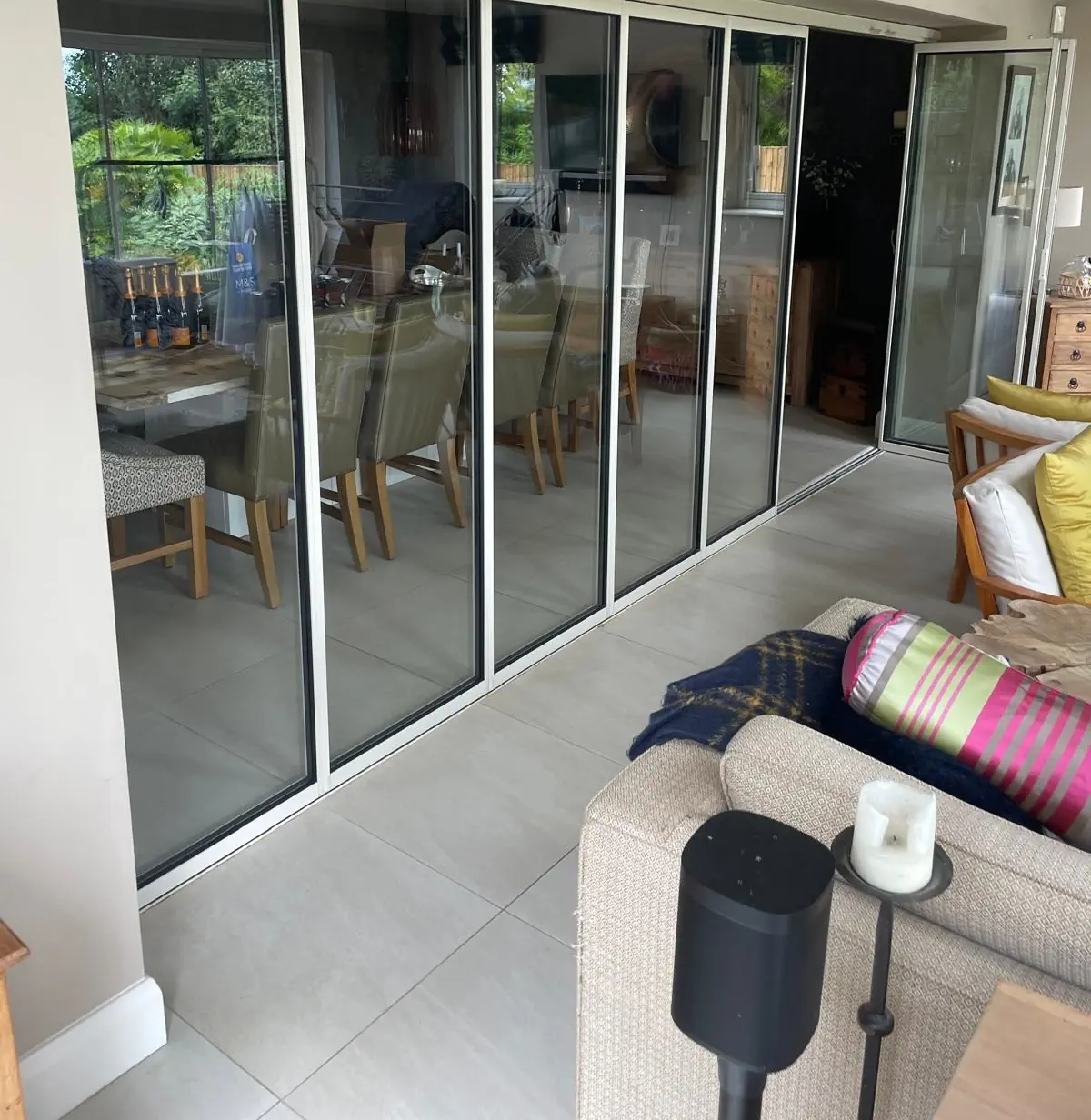
Dividing spaces flexibly sets modern buildings apart. Internal aluminium folding doors excel in both homes and commercial applications, where they split large areas into smaller zones without blocking light. Their robust frames handle frequent use while keeping their good looks.
Glass bifold internal doors bring natural light deeper into buildings. When closed, they maintain sight lines through spaces while providing sound insulation between areas. Opening them wide creates sociable spaces perfect for entertaining or collaborative work.
Internal spaces pose different challenges than external walls. Aluminium bi folding doors need less weatherproofing inside, allowing for slimmer frames that look more delicate. The reduced weight makes them easier to operate, ideal for daily use in busy spaces.
Room Dividers
Open-plan living brings its own challenges. Aluminium folding doors provide the perfect middle ground between completely open and fully separated spaces. They let you change how rooms work throughout the day—closed for quiet time, open for family gatherings.
Busy family homes benefit from adaptable spaces. Bi fold aluminium doors between a kitchen and dining room let parents keep an eye on homework while cooking, then close for peace during dinner parties. The panels glide smoothly even after years of use, thanks to high-quality runners and bearings.
Natural Light
Dark hallways and windowless rooms gain most from internal glazing. Adding aluminium bifold doors between spaces shares natural light from windows, making the whole house feel brighter and more spacious. Unlike solid walls or regular doors, they maintain visual connections between spaces even when closed.
Office spaces and meeting rooms need flexible boundaries. Internal aluminium folding doors create quiet zones for focused work while keeping sight lines open. Their acoustic properties help control noise levels without making spaces feel isolated or cramped.
Aluminium Bifold Doors Colours
Colour sets the tone for any architectural feature. Modern aluminium folding doors are often available in over 150 RAL colours, from subtle whites to bold statement shades. Each finish affects how your doors look in different lights and how they work with your home’s style.
Powder Coating
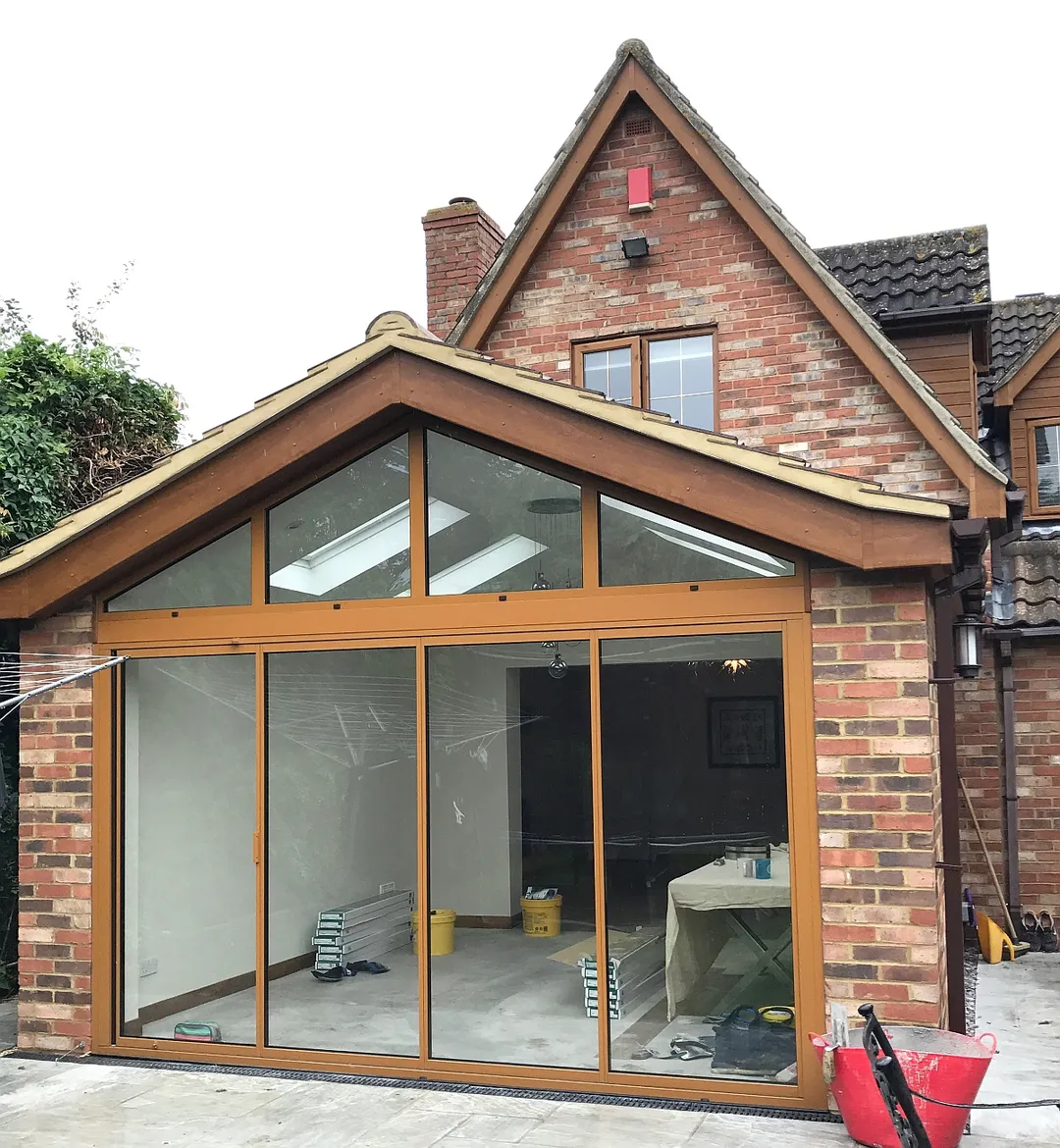
The powder coating process gives aluminium bi fold doors their lasting colour. Unlike wet paint, powder forms a tough shell when baked onto the metal. This resilient layer resists scratches, fading, and peeling while keeping its rich appearance for decades.
Anthracite grey leads current colour trends, offering a sophisticated look that suits most homes. The deep tone works equally well with traditional brick and contemporary rendered walls.
Professional coating happens in controlled factory conditions. Aluminium folding patio doors receive multiple layers of preparation before the powder goes on. Each stage—cleaning, priming, coating, and baking—adds to the finish’s durability and appearance.
Textured finishes provide practical benefits beyond pure aesthetics. These surfaces hide minor marks better than smooth ones and give bifold aluminium doors extra character. The subtle variations catch light differently throughout the day, adding visual interest to your installation.
Anodising
Anodising creates metallic finishes that powder coating can’t match. This process changes the actual surface of aluminium folding doors, making them even more resistant to wear and coastal conditions.
The anodising process penetrates deep into the metal itself. Unlike surface coatings, it can’t chip or peel because it’s part of the aluminium structure. The resulting finish has a unique depth that changes subtly as light moves across it.
Chemical processes during anodising create distinctive effects. Bronze, silver, and gold tones emerge from carefully controlled reactions. Each shade has its own character, giving designers more options for high-end projects.
Two-Tone Finishes
Different colours inside and out let doors match both interior and exterior schemes. Aluminium bi-fold doors can wear one colour facing the garden and another inside your home. This flexibility helps them fit perfectly into your design plans.
Dual colours need careful planning during manufacture. Each piece receives its finish separately before assembly, ensuring clean lines between different shades. The extra work pays off in a more coordinated look throughout your space.
White remains popular for interior faces of doors. It works well with most room colours and helps reflect light back into the space. The clean look suits both modern and traditional interiors while making rooms feel larger.
Choosing colours means thinking about the long term – while bold shades might appeal today, neutral tones often prove more versatile as tastes change. The right finish makes aluminium folding doors look perfectly at home for years to come.
Some coatings change their appearance as you move around them, while others mimic materials like bronze or steel. These options let architects specify exactly the right look for each project.
Aluminium Folding Doors FAQ
What are aluminium folding doors?
Aluminium bi fold doors consist of multiple glass panels connected by hinges that fold back against each other. The panels run along a track system fitted to the top and bottom of your door frame, letting you push them to one or both sides to create a wide opening.
Are aluminium bifold doors worth the money?
Bifold aluminium doors offer excellent value thanks to their durability and energy efficiency. High-quality systems last decades with minimal maintenance, while robust locking systems and thermal breaks help cut energy bills. The slim frames and large glass panels bring in more natural light than standard doors or windows, making rooms feel bigger and brighter.
How long do custom made folding doors take to manufacture?
Made to measure folding doors typically take 4-8 weeks from order to delivery. Each door is crafted specifically for your opening, so the manufacturing process includes precise cutting, assembly, finishing and quality checks.
Can you have bifold doors upstairs?
Aluminium bi folding doors work well on upper floors, especially for balconies or roof terraces. The light weight of aluminium compared to other materials makes them ideal for upstairs installations, while proper weatherproofing keeps the elements out even in exposed locations.
What’s the best colour for aluminium folding doors?
Aluminium folding doors often come in over 150 RAL colours, but anthracite grey remains the most popular choice for British homes. The deep, neutral shade works with both traditional and modern architecture while hiding dirt and marks better than lighter colours.
Can bifold doors be fitted with blinds?
Aluminium bi fold doors can incorporate integrated blinds sealed between the glass panes. These never need dusting and won’t get damaged during door operation. The blinds raise, lower and tilt using magnetic controls on the frame, giving you easy control over light and privacy.
What are thermal breaks in aluminium folding doors?
Aluminium folding doors use plastic strips between the inner and outer frame sections to prevent heat transfer. Without these thermal breaks, the metal would conduct cold from outside to inside. Modern systems use multiple chamber breaks for better insulation.
Are bifold doors suitable for period properties?
Bifold aluminium doors can complement period homes when chosen carefully. While obviously modern, their slim frames intrude less on traditional architecture than chunky timber alternatives. The key lies in selecting sympathetic colours and hardware that match your home’s era.
Traditional brass or chrome handles suit Victorian and Edwardian properties, while bronze finishes work well with Arts and Crafts homes. Subdivision of the glass panels can echo existing window patterns, helping the doors blend with period features.
About SunSeeker Doors
With over 20 years of experience, SunSeeker Doors remains at the forefront of door design with our quality-tested patio doors and related products, including the bespoke UltraSlim aluminium slide and pivot door system, Frameless Glass Doors, and Slimline Sliding Glass Doors. All of our doors are suitable for both internal and external use.
To request a free quotation, please use our online form. You may also contact 01582 492730, or email info@sunseekerdoors.co.uk if you have any questions.


